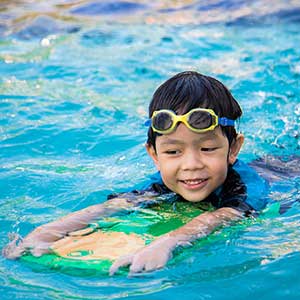Keep kids safe this Summer with Pool safety rules
- Posted On:
- Written By: Tulane Lakeside Hospital

The warm weather of summer heralds the start of pool season, and unfortunately, young swimmers end up in the hospital every year. Childhood drowning is the leading cause of unintentional death in children age 1-4 and the second-leading cause in ages 5-14, which means countless lives can be saved every year by learning and following strict pool safety rules.
The RESPECT set of guidelines will give you a comprehensive plan for keeping kids safe around water. This stands for:
Recognition
Education
Supervision
Physical barriers
Expectations
Communication
Training
Recognition: This means knowing the signs of a non-swimmer, such as someone in a pool who is tired, in distress or on the verge of drowning.
Education: You need to know the conditions of the environment, the water and the abilities of each swimmer. Be aware that drowning is a very real threat anywhere, anytime.
Supervision: Swimmers need active, direct and constant supervision. They are the only priority of whoever is tasked with watching them.
Physical barriers: You must have fences and locked gates as required by law. You also need to utilize pool covers and alarms to prevent unguarded access.
Expectations: Be aware of your (and other swimmers’) physical limitations. Understand the environment to anticipate any potential problems.
Communication: Make sure everyone in the pool is aware of what kinds of activities are acceptable and which create risks.
Training: Make sure those who are around the water know the basics of swimming, including supervisors. Training also can include first aid and CPR.
The American Red Cross offers a number of CPR, first aid and water safety classes in the New Orleans area. Learn more by visiting the American Red Cross website.
If you have a pool, you should have a rescue pole with a life hook and life preserver readily available for emergencies. The first attempt at a rescue should use these devices so that the potential for another person to need emergency assistance is minimized.
Secondary drowning or dry drowning
Secondary drowning and dry drowning are also concerns when kids are spending time in water. Secondary drowning occurs when water gets into a child’s lungs and builds up, causing a condition called pulmonary edema. Dry drowning happens when water only reaches as far as a child’s vocal cords, causing them to spasm and close up.
Both conditions can cause immediate breathing trouble to up to 24 hours later. If after spending time in the water a child has consistent coughing, chest pain, trouble breathing, or extreme fatigue, it’s vital to provide him or her with emergency care.
Follow these steps, and you and your family will have a fun and safe time in, and around the pool, this summer!